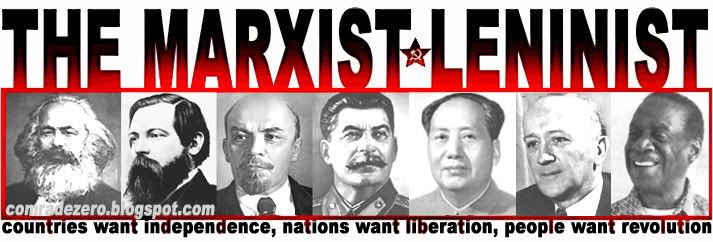Explaining the new ML blog header
Going clockwise from the left, the Little Red Book (Quotations from Chairman Mao Zedong) is first. This book was the textbook for the Great Proletarian Cultural Revolution in China, and serves as an excellent manual on how to conduct a revolutionary struggle (here is a neat site about the red book). It is a symbol of Mao Zedong Thought.
Next is Paul Robeson, one of the greatest mass leaders in American history. He was an actor, a singer, and an athlete, awarded the Stalin Peace Prize (the Soviet version of the Nobel Peace Prize) in 1952 for his leading role in the formative years of the Civil Rights Movement and his devotion to the defense of peace and opposition to imperialism throughout the world.
Beneath and to the right of Robeson is Frantz Fanon's great book, The Wretched of the Earth. This book, written by a Black psychologist, trained in France and heavily influenced by Marxism, not to mention an active participant in the Algerian Revolution, is essential for understanding the relationship between oppressor and oppressed and structures of colonial dominance and resistance. This is a book that a lot of influence upon me in my formative period when I was first studying the theory and practice of the Black Panther Party, who were heavily influenced by this book (along with the works of Kwame Nkrumah and Maoism) because of its insistanc that the lumpenproletariat should be the leading force in national liberation struggles. (See the wikipedia article on Fanon's major book.)
Next is Harry Haywood, the great African American Communist. He was a leading theorist in the CPUSA regarding the national question in the United States. His most important contribution is the development of the theory of an African American national territory in the Black Belt South based on the understanding of the Marxist line on the national question developed by Lenin and Stalin (see the section on Haywood in my article on the National Question for more this). He wrote several important theoretical works, the most important of which is Negro Liberation. His autobiography, Black Bolshevik: Autobiography of an Afro-American Communist is a very important critical and self-critical look at the CPUSA from its foundations to beyond WWII. He is also important as a founding figure of the antirevisionist movement in the United States as he struggled against rising revisionist currents in the CPUSA, with whom he eventually broke to join with the young Maoist groups of the New Communist Movement (see also the wikipedia article on Harry Haywood).
Following the picture of Haywood is a painting of Mao Zedong, leader of the Chinese Revolution and the most important Marxist-Leninist theorist following Marx, Engels, Lenin, and Stalin. He is particularly important for developing the theory and practice of national-democratic revolution as a step toward socialist revolution, for developing the Marxist theory of People's War, and for developing and leading the struggle against modern revisionism. He enriched the Leninist theory of proletarian revolution in his formulations of the mass line, the united front, and the continuation of class struggle under socialism. His philosophical contributions, namely his work on dialectical materialism, are an incredible weapon in the hands of Marxist-Leninist organizations struggling to build a revolutionary movement to fight for socialism. He continues to be a great inspiration for poor and oppressed people all over the world.
After Mao, we see someone inspired by Maoism to fight people's war - a female People's Liberation Army soldier in Nepal, where today the Communist Party of Nepal (Maoist) is leading the New Democratic revolution. I always thought that was such a beautiful and inspiring picture, the way the traditional blanket she is wrapped in to protect her from the early morning cold as she keeps watch contrasts to the sleek, black M-16 that has been liberated from the enemy. The Communist Party of Nepal (Maoist) are one of the most important and challenging forces in the Communist Movement today.
Che Guevara is next. Che, in my opinion, embodied the proletarian internationalist spirit. Born in Argentina, Che met the remarkable revolutionary leader Fidel Castro in Mexico and set out with him and handful of others to fight a victorious guerrilla war on U.S. imperialism's doorstep. After serving for a time as chief economist for Socialist Cuba, he set out to the Congo and then Bolivia to help other countries kick imperialism off of their soil. He was summarily executed by a FBI agent when he was captured while fighting with guerrillas in Bolivia. He continues to inspire the revolutionary and radical youth all over the world (check out the Che Guevara Archive).
Next we see a map of the Southern United States, highlighting the Black Belt. Not only is this where I live and where I grew up, but this is also the historically constituted territory of the African American Nation in the U.S., forged through the lengthy process of slavery, the betrayl of the national-democratic revolution of Reconstruction, and frozen in place by the rise of monopoly capitalism. It is the area of the greatest concentration of African American's in the U.S. The demand for self-determination for African Americans in the Black Belt is perhaps the most important demand for the proletarian revolution in the United States, as it is the source of genuine equality for African Americans, which in turn is the basis for real Black/white working class unity. Read the Comintern resolutions of 1928 and 1930 on the Black Belt Nation.
Next is the leader of the Popular Front for the Liberation of Palestine, the strongest Marxist-Leninist group in the Middle East, Ahmed Sadaat. Long a prisoner under the supervision of British and U.S. guards in a Jericho prison, he was recently kidnapped in an Israeli raid on the prison after his election to the Palestinian parliament. Here is a great interview with Sadaat just before his kidnapping by Israel.
We see, following Huey, a book - Stalin's Marxism and the National and Colonial Question, which is the most important collection of texts on the national question by the leading theorist of the national question within the Marxist-Leninist movement. This book, along with his study with the Comintern and five years in the Soviet Union as a member of the CPSU, had a great influence on African American Communist, Harry Haywood. Here is a link to the central text in that book, Marxism and the National Question. I think understanding this is essential to understanding Marxism-Leninism.
Next is a picture of your's truly, Comrade Zero, at an anti-NED (National Endowment for Democracy) demo in Washington D.C following the conference that founded the Venezuela Solidarity Network. The sign I'm holding reads, "Self-determination: endow this".
Below the anti-NED picture is a picture of William Z. Foster. Foster was a leader of the CPUSA who struggled for a correct line in the Party until his retirement. As a powerful trade-unionist, Foster probably did more for our class than anyone else in the history of this country. He also wrote two very important books, History of the Three Internationals, and History of the Communist Party of the United States.
To Foster's left we see a photo of Malcolm X holding a M-1 carbine - he was, like me, not a pacifist, and believed in getting freedom "by any means necessary". Arguably the most important figure in the Black Nationalist movement in the U.S., Malcolm was a leader in the Nation of Islam, until his pilgramage to Mecca. Then he broke with the NOI's founder, Elija Muhammed, over what he saw as the NOI's racism and bourgeois seperatism. He remained a firm Black Nationalist and a militant pole in the Civil Rights Movement of the Sixties. He was outspoken in his demands for revolution, armed resistance, self-determination, and, in his later years, socialism. You can listen to his important speech, "Message to the Grassroots", here. His autobiography was a tremendous inspiration for me when I was in high school and just beginning to develp a little class consciousness.
On the other side of the Nepalese Maoist woman (discussed above), we see Vladamir Illych Lenin. And why is Lenin here? Though I would think that would be self-explanatory, I'll just give this little quote from his great pupil, Stalin:
Leninism is Marxism of the era of imperialism and proletarian revolution. To be more exact, Leninism is the theory and tactics of the proletarian revolution in general, the theory and tactics of the dictatorship of the proletariat in particular (Foundations of Leninism).
To be a Marxist today is to be a Leninist.
Next to Lenin, we see another female Guerrilla fighter. This time a member of Colombia's largest Marxist-Leninist group, the FARC-EP. The FARC, in the face of the most brutal dictatorship (which just so happens to be a recipient of tremendous amounts of U.S. military aid under the auspices of Plan Colombia), and the paramilitaries linked to it, is in the vanguard of the struggle for national liberation and socialism in Latin America, and they have been fighting a protracted guerrilla war since the late 60s. She is marching with her comrades in a military drill. They are all carrying AK-47s.
After the FARC, there is the famous photo of a Red Army soldier raising the red flag over the Reichstag in Berlin at the close of WWII. The Soviet Union, under the leadership of Stalin and with the heroic effort of the people of the USSR, was the leading force in the united front that defeated Hitlerite Fascism. The victory of the people of the world over fascism was one of the great moments of the 2oth century and has a tremendous impact on where we are today.
Last, but certainly not least, is a picture of members of the heroic Iraqi Resistance carrying Automatic Kaloshnikov assault rifles. The Iraqi Resistance is currently leading the national liberation struggle of the Arab people against U.S. imperialism and is on the leading edge of the struggle in the region. I believe Iraq will the Stalingrad of U.S. Imperialism.
Labels: Black Belt, Black Panthers, Che Guevara, Fanon, FARC, Harry Haywood, Huey Newton, Iraqi Resistance, Lenin, Malcolm X, Mao, Maoism, National Question, Nepal, Palestine, Sadaat, Stalin, William Foster
View Post











